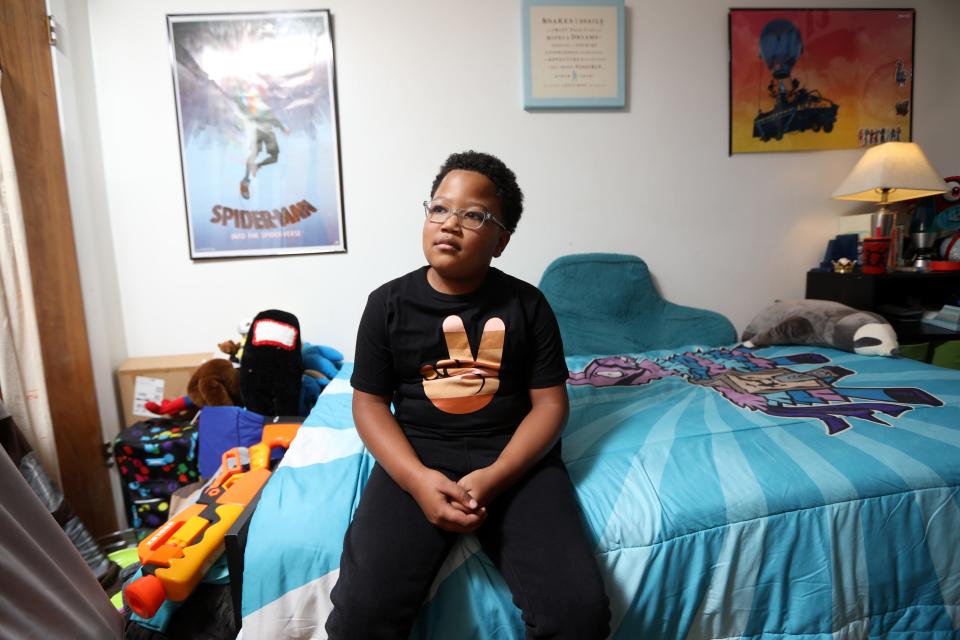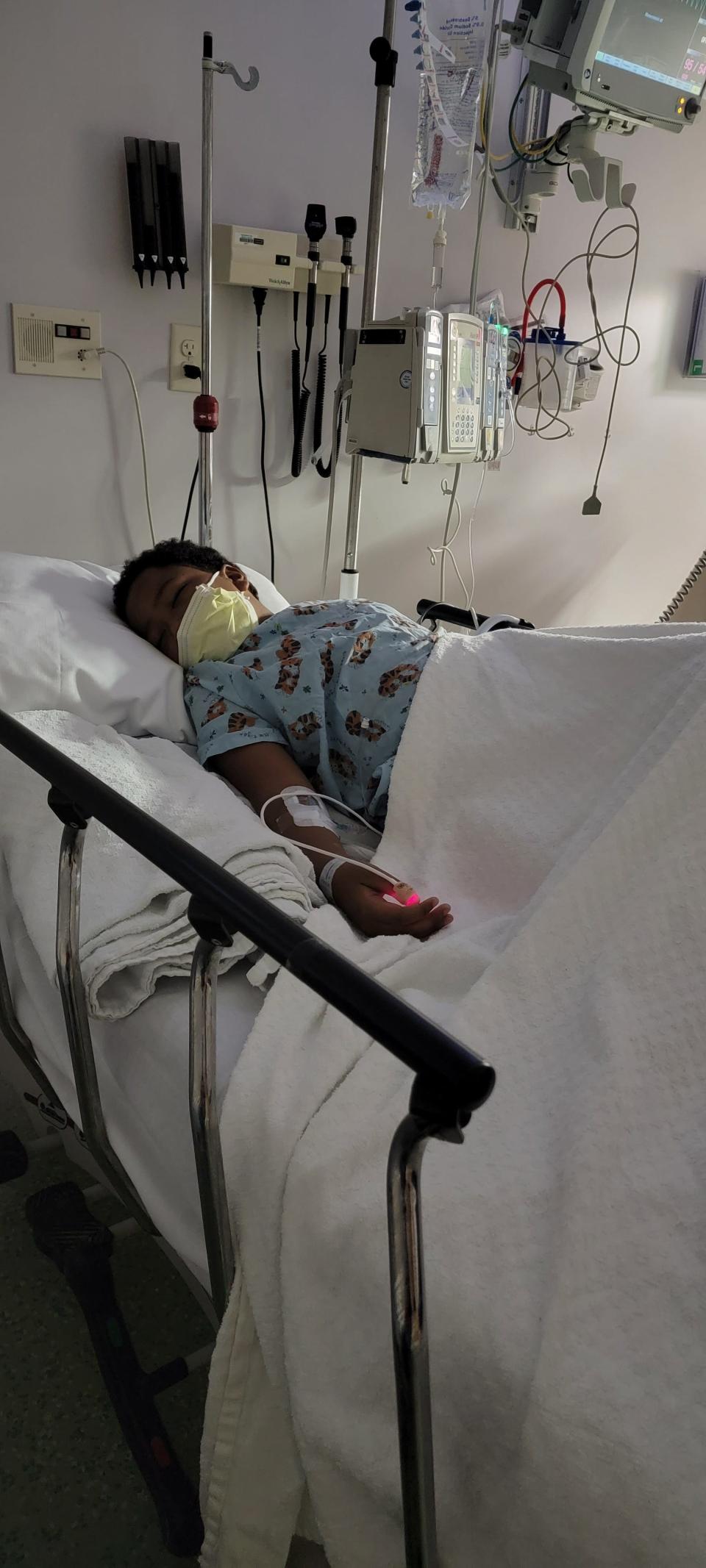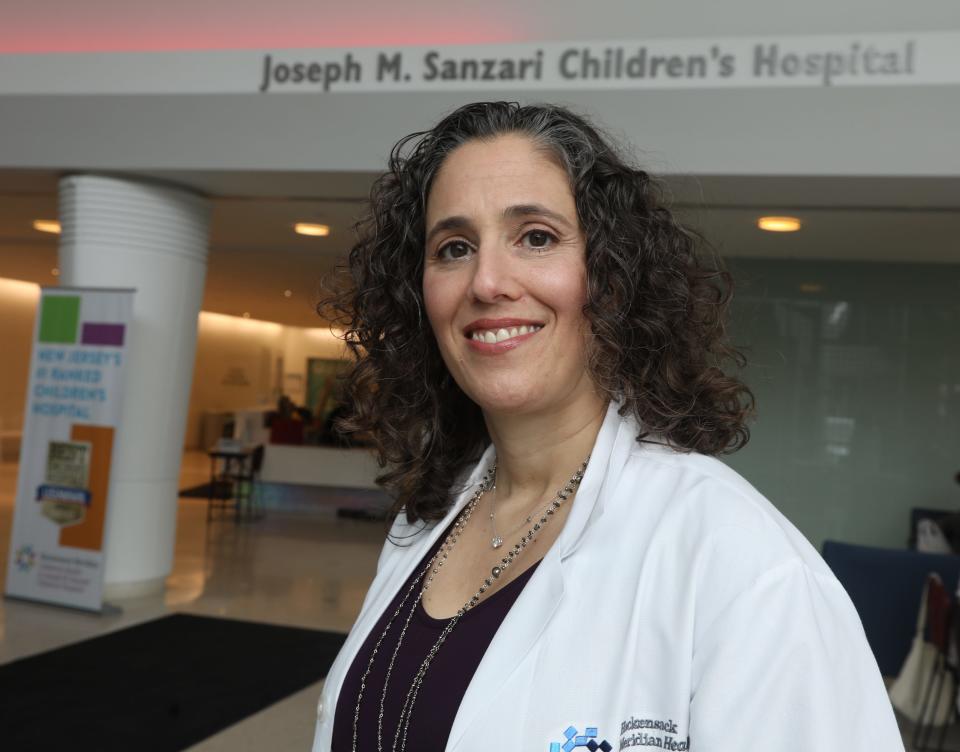Muscle pain, fatigue, brain fog: Doctors grapple for answers about long COVID in kids
- Oops!Something went wrong.Please try again later.
The end of New Jersey’s school mask mandate on March 7 could feel like a return to normalcy for many, but it willnot end COVID-19’s disruptive long-term consequences for a small but significant number of children — consequences that may ultimately touch many more.
They are kids such as Allie Trolaro, a high school junior from Oakland whose joy in competitive dancing has been undercut by months of extreme muscle pain and fatigue, and Chafin Pyle, a third grader in Jersey City who came out of the hospital on Christmas Day after a harrowing week of raging fevers and abdominal pain — and is still not quite himself.
Scientists don’t know what proportion of kids like Allie will struggle with “long COVID,” in which COVID’s debilitating symptoms linger for a month or more. Researchers are trying to determine what makes some children suffer so long when others do not, and how to treat them.
Nor do they know why some kids develop a potentially life-threatening eruption of their immune system a few weeks after coronavirus infection, even in some cases — like Chafin’s — when the infection caused no outward symptoms. This rare diagnosis, called multisystem inflammatory syndrome in children (MIS-C), has become more frequent as COVID-19 cases have increased.

More than 102,000 New Jersey schoolchildren have tested positive for COVID during the current school year. Across the country, 4.2 million children have become infected since the new year began, making January by far the pandemic’s worst month for children.
More New Jersey children were diagnosed with MIS-C last month — 23 — than in any previous month of the pandemic, and seven more were diagnosed in the first week of February. Five of those children are currently hospitalized. Since the start of the pandemic, 182 have needed hospital care. Peaks in such diagnoses usually follow the crest of the COVID wave by a month.
“We've become numb to it, because the proportion of kids who get very sick is substantially less than that of adults,” said Dr. Lawrence Kleinman, a Rutgers professor of pediatrics who leads a federally funded study of long COVID in children.
It’s too soon to know what impact these health issues may have on the children’s futures. Unlike adults, they have been affected at a formative stage — learning difficulties they experience now may have repercussions for years to come, and heart or lung damage could create lifelong vulnerabilities.

Over a lifespan, children may suffer a bigger impact than adults, Kleinman said, and research funding should reflect that. “We would not be downplaying this in kids if it were not dwarfed by the long-term impact in adults,” he said.
The focus should be on the actual number of kids with post-COVID complications, rather than percentages, he said.
Masks: As Murphy lifts school mask mandate, here's where masks are still required in NJ
Hurting from head to toe
For the children and their families experiencing these post-COVID illnesses, none of the statistics matter. When an uncommon outcome affects a loved one, the disruption and anxiety are all too real.
Many children remain vulnerable to COVID. Vaccines are not yet available for children younger than 5, and a smaller proportion of 5- to 11-year-olds are vaccinated against COVID than any other eligible age group. Two out of three children of that age in New Jersey remain unvaccinated.
While most kids who get infected fully recover. those who don't face a tough struggle.
“This was so scary,” said Chafin’s mother, Christine Parker.
Story continues below video
“From his head to his toes, everything hurt him,” said the third grader's father, Chafin Pyle Sr. “So much pain from a kid that is never in pain.” They asked their son to describe the level on a scale of one to 10, and “it was a 10, 10, 10."
“This should be enough to get people to protect their own children,” Pyle said. Seeing a child so sick should eliminate arguments about precautions such as vaccination, masking and social distancing, he suggested.
Allie Trolaro, the high school junior, was at a national dance competition when she first realized something was really wrong, she said. Her heart raced. Her breath was short. She felt dizzy, mentally foggy. Her mother figured she must be nervous. But then, when the family went on vacation in the Adirondacks the following week, Allie just wanted to nap. That was completely out of character.

Now, she feels constant fatigue and deep muscle aches. She is a patient at Hackensack Meridian Children’s Health Pediatric COVID Recovery Center.
“I want to do well,” she said. But “I can’t focus because I’m tired all the time. I have anxiety because it’s so nerve-wracking to get myself to go to dance.” Sometimes she goes to school late because of her fatigue. She used to dance 17 hours a week — jazz, tap, ballet, contemporary — and tries to now, but feels sick and achy afterward.
“I keep pushing through every day,” she said. “But I push and then I crash. I push and crash, push and crash. It’s not a real good way of living."

“COVID is something that affects a lot of people — I’ve always understood that," she said. "But I never knew it could do this. … When you say, ‘If I get COVID I'll do fine’ — you never know.”
“She tries really hard to try to feel like herself,” her mother, Leslie Trolaro, said, expressing empathy for other families going through the same thing. “Unfortunately, here we are seven months later and she’s still suffering with these symptoms.”
Omicron: As omicron wanes in NJ, here's where experts think the COVID pandemic is headed next
Losing ability to do math
The Pediatric COVID Recovery program at Hackensack Meridian has about 100 patients, most of them “long-haulers” like Allie, said Dr. Jennifer E. Weiss, its co-director and a pediatric rheumatologist.
“My concern is we’re going to be seeing more patients in another few weeks,” she said, as the surge of infections in late December and January plays out.
Most of the long-haulers are referred by pediatricians in the community. They are predominantly girls and tend to be teens and tweens, though some are college age, Weiss said.
Story continues below video
At the Pediatric Post-COVID CARE Program of RWJBarnabas Health, Dr. Uzma Hasan, a pediatric infectious disease specialist, has seen about 150 children. The program treats patients in Newark and Livingston.
Most long-haulers are 12 to 17 years old, she said. “The athletes mostly have a hard time recovering,” she said. “They are Type A hyper-achievers who do everything right, who were in multiple sports, who struggle to get back to baseline function.”
Another pediatrician described her patients: “They will tell you they try to read a paragraph, and they read it 10 times and don’t know what it means,” said Dr. Margaret Fisher, an infectious disease specialist, board member of the American Academy of Pediatrics and adviser to the state Health Department. “Some children lose their ability to do math.” In some patients, any activity can make the symptoms worse.
Her patients are not malingerers, she said. School systems should be aware of the diagnosis and make accommodations, Hasan said, because learning is affected.
Treatment varies according to symptoms.
The children get physical therapy for joint pain. Some learn to use guided imagery, biofeedback and self-hypnosis to cope with stress and pain, Weiss said. She talks to them about regular sleep habits, because many experience disruption of their sleep cycles.

Hasan has found that the treatment used for chronic fatigue syndrome — “both mind and body retraining” — has been helpful with those who have post-COVID symptoms.
The COVID vaccine’s role in both prevention and treatment of long COVID is still under study.
Some research suggests that a significant portion of those with long COVID symptoms feel better after a COVID vaccine, although others feel worse. Vaccination against COVID can protect against long COVID by preventing infection in the first place. But some with breakthrough infections still get long COVID symptoms, although they appear to be milder.
For Allie, the only treatment that has helped is acupuncture. A day after an acupuncture session, she feels great, she said. Then its effect wanes. “I still barely get through the week,” she said. She takes supplements to bolster her immune system and medication to help with anxiety.
“Unfortunately,” said her mother, a pediatric intensive care nurse at a different hospital, “we don’t know enough about long COVID to treat these kids super-efficiently.”
Research getting started at Rutgers
Recruitment will start “very soon” for participants in what many hope will be the definitive study of the long-term and delayed effects of COVID in children.
Rutgers anticipates it will receive $30 million from the National Institutes of Health, with Kleinman, of the Rutgers Robert Wood Johnson Medical School, spearheading a national consortium that aims to bring several thousand children into the study.
Here’s what researchers are trying to learn about what they call “post-acute sequelae of SARS-CoV-2 infection (PASC)”:
How frequently do kids develop long COVID or multisystem inflammatory syndrome, or more generally, not get back to normal after their infection?
How are they affected physically, developmentally and behaviorally? What impact do these post-COVID symptoms have on the functioning of their brain, heart, lungs and even cells?
What are the combinations of symptoms or findings that constitute long COVID?
Are there risk factors that predispose children to develop either syndrome? Are there factors in the virus itself and its mutations that explain its effects?
What role do vaccines play?
It is a complex study that involves many researchers and children’s hospitals, including those at Hackensack Meridian Health and RWJBarnabas Health, along with the American Academy of Pediatrics and the American Academy of Family Physicians. With a blitz of recruitment, Kleinman hopes to enroll the participants within a year.
Results will take longer, but some preliminary findings could be available as soon as late 2022, he said.
“We have a lot to learn about long COVID,” he said. “People are working very, very hard to get this right.”
Lindy Washburn is a senior health care reporter for NorthJersey.com. To keep up-to-date about how changes in health care affect you and your family, please subscribe or activate your digital account today.
Email: washburn@northjersey.com
Twitter: @lindywa
This article originally appeared on NorthJersey.com: Long COVID symptoms: Muscle pain, fatigue, brain fog in kids

